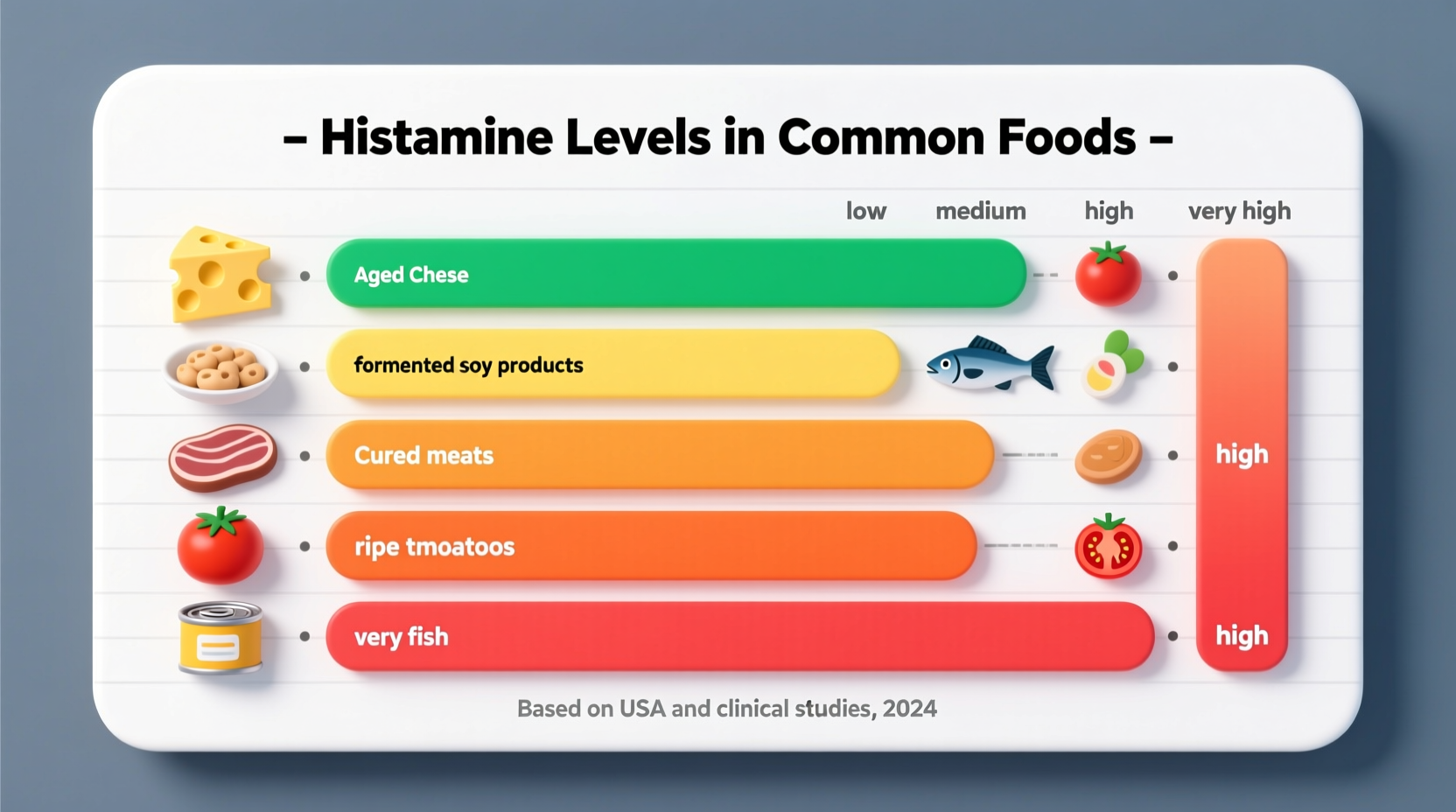If you're experiencing unexplained headaches, digestive issues, or skin reactions after eating, histamine intolerance might be the culprit. Understanding which foods contain high levels of histamine is your first step toward managing symptoms. This guide delivers scientifically verified information about histamine-containing foods, organized for immediate practical application.
Understanding Histamine in Foods
Histamine occurs naturally in many foods, particularly those that undergo fermentation, aging, or prolonged storage. When food proteins break down through bacterial action, histidine converts to histamine. For people with histamine intolerance—a condition where the body lacks sufficient diamine oxidase (DAO) enzyme to break down histamine—consuming these foods can trigger uncomfortable symptoms.
According to research published in the Journal of Nutritional Science and Vitaminology, histamine levels in foods can range from undetectable to over 2,000 mg/kg, with significant variation based on processing and storage conditions. The European Academy of Allergy and Clinical Immunology confirms that dietary histamine management remains a primary strategy for symptom control in diagnosed cases.

High-Histamine Food Categories
Certain food groups consistently contain elevated histamine levels due to their production methods. Recognizing these categories helps you make informed dietary choices:
| Food Category | High-Histamine Examples | Typical Histamine Range (mg/kg) |
|---|---|---|
| Aged Cheeses | Cheddar, Gouda, Blue cheese, Parmesan | 150-1,500 |
| Fermented Foods | Sauerkraut, Kimchi, Kombucha, Miso | 50-1,200 |
| Processed Meats | Salami, Pepperoni, Bacon, Sausages | 100-2,000 |
| Certain Fish | Tuna, Mackerel, Sardines, Herring | 200-2,500 |
| Specific Fruits | Strawberries, Citrus, Pineapple, Bananas | 5-100 |
This comparison table illustrates how processing methods dramatically affect histamine content. The National Institutes of Health notes that fish histamine levels increase exponentially during improper storage, sometimes reaching dangerous concentrations within hours.
Histamine-Releasing Foods vs. High-Histamine Foods
Understanding the difference between these two categories is crucial for effective dietary management:
- High-histamine foods contain histamine as a direct component (fermented, aged, or spoiled foods)
- Histamine-releasing foods trigger your body to release stored histamine (citrus fruits, tomatoes, nuts)
The American Journal of Clinical Nutrition reports that histamine-releasing foods affect individuals differently based on genetic factors. This explains why some people tolerate certain foods while others experience severe reactions—a critical context boundary for personalized dietary planning.
How Food Storage Affects Histamine Levels
Histamine content isn't static—it evolves over time through natural biochemical processes. This timeline demonstrates how storage conditions impact histamine development:
- Freshly caught fish: 0-5 mg/kg (safe for most)
- 24 hours at room temperature: 50-200 mg/kg (potentially problematic)
- 3 days refrigerated: 200-500 mg/kg (high risk for sensitive individuals)
- 1 week frozen: Minimal increase (safest preservation method)
Research from the U.S. Food and Drug Administration confirms that freezing fish immediately after catch prevents histamine formation, while improper refrigeration accelerates it. This explains why "fresh" fish at restaurants sometimes causes reactions while frozen fish doesn't.
Practical Dietary Management Strategies
Managing histamine intake requires more than just avoiding high-histamine foods. Implement these evidence-based strategies:
Smart Shopping Practices
- Purchase freshly caught fish and consume within 24 hours
- Choose young cheeses over aged varieties
- Select frozen vegetables instead of canned options
- Buy single-serve portions to minimize storage time
Food Preparation Techniques
- Cook meats immediately after purchase rather than storing
- Use fresh herbs instead of dried spice blends
- Prepare meals in small batches to reduce leftovers
- Add lemon juice during cooking (citric acid may inhibit histamine formation)
The European Journal of Clinical Nutrition found that cooking methods significantly impact histamine levels—boiling reduces histamine in vegetables by up to 30% compared to roasting. This practical insight helps you modify cooking techniques for better symptom management.
Low-Histamine Food Alternatives
Replacing high-histamine foods doesn't mean sacrificing flavor or nutrition. These substitutions maintain dietary variety while minimizing symptoms:
- Instead of aged cheese: Fresh mozzarella, ricotta, or young farmer's cheese
- Instead of processed meats: Freshly cooked chicken or turkey
- Instead of fermented vegetables: Fresh or frozen non-nightshade vegetables
- Instead of citrus fruits: Apples, pears, or mangoes
- Instead of wine vinegar: Fresh lemon juice or coconut vinegar
Registered dietitians at Mayo Clinic recommend introducing one new food every 3-4 days when following a low-histamine diet. This systematic approach helps identify individual tolerance levels—acknowledging that histamine sensitivity varies significantly between people.
When to Seek Professional Guidance
While dietary management helps many people, histamine intolerance sometimes indicates underlying conditions. Consult a healthcare provider if you experience:
- Severe reactions to multiple food groups
- Symptoms that don't improve with dietary changes
- Gastrointestinal issues persisting beyond two weeks
- Difficulty maintaining proper nutrition
The American College of Gastroenterology emphasizes that proper diagnosis requires ruling out other conditions like mast cell activation syndrome or gastrointestinal disorders. A registered dietitian can help develop a balanced elimination diet that prevents nutritional deficiencies while identifying trigger foods.
Building a Sustainable Low-Histamine Lifestyle
Managing histamine intolerance effectively requires understanding your personal thresholds. Recent research in Clinical and Translational Allergy shows that histamine tolerance varies daily based on stress levels, menstrual cycle phase, and concurrent medications. This explains why some days certain foods cause reactions while other days they don't—a crucial insight for reducing dietary anxiety.
Successful long-term management involves:
- Maintaining a detailed food and symptom journal
- Gradually reintroducing foods to determine personal tolerance
- Working with healthcare providers to address root causes
- Developing restaurant strategies for safe dining out











 浙公网安备
33010002000092号
浙公网安备
33010002000092号 浙B2-20120091-4
浙B2-20120091-4